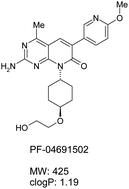Discovery of the highly potent PI3K/mTOR dual inhibitor PF-04691502 through structure based drug design†
Abstract
The

* Corresponding authors
a
Cancer Chemistry, Pfizer Worldwide Research and Development, La Jolla Laboratories, 10770 Science Center Drive, San Diego, CA 92121, U.S.A
E-mail:
henry.cheng@pfizer.com
Tel: +1 (858) 622-3208
b Oncology Research Unit, Pfizer Worldwide Research and Development, La Jolla Laboratories, 10770 Science Center Drive, San Diego, CA 92121, U.S.A.
c PDM, Pfizer Worldwide Research and Development, La Jolla Laboratories, 10770 Science Center Drive, San Diego, CA 92121, U.S.A.
The

 Please wait while we load your content...
Something went wrong. Try again?
Please wait while we load your content...
Something went wrong. Try again?
H. Cheng, S. Bagrodia, S. Bailey, M. Edwards, J. Hoffman, Q. Hu, R. Kania, D. R. Knighton, M. A. Marx, S. Ninkovic, S. Sun and E. Zhang, Med. Chem. Commun., 2010, 1, 139 DOI: 10.1039/C0MD00072H
To request permission to reproduce material from this article, please go to the Copyright Clearance Center request page.
If you are an author contributing to an RSC publication, you do not need to request permission provided correct acknowledgement is given.
If you are the author of this article, you do not need to request permission to reproduce figures and diagrams provided correct acknowledgement is given. If you want to reproduce the whole article in a third-party publication (excluding your thesis/dissertation for which permission is not required) please go to the Copyright Clearance Center request page.
Read more about how to correctly acknowledge RSC content.
 Fetching data from CrossRef.
Fetching data from CrossRef.
This may take some time to load.
Loading related content
